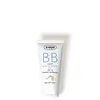What's inside
What's inside
 Key Ingredients
Key Ingredients

 Benefits
Benefits

 Concerns
Concerns

 Ingredients Side-by-side
Ingredients Side-by-side

Water
Skin ConditioningParaffinum Liquidum
EmollientGlycerin
HumectantTridecyl Trimellitate
EmollientGlycol Palmitate
EmulsifyingCaprylic/Capric Triglyceride
MaskingCanola Oil
EmollientTriceteareth-4 Phosphate
EmulsifyingFructooligosaccharides
HumectantMannitol
HumectantXylitol
HumectantRhamnose
HumectantLaminaria Ochroleuca Extract
Skin ConditioningGlycyrrhetinic Acid
Skin ConditioningGlycine Soja Germ Extract
EmollientAllantoin
Skin ConditioningGinkgo Biloba Leaf Extract
Skin ConditioningCamellia Sinensis Leaf Extract
AntimicrobialPropylene Glycol
HumectantPentylene Glycol
Skin ConditioningCaprylyl Glycol
EmollientGlycol Stearate
EmollientPEG-2 Stearate
EmulsifyingAcrylates/C10-30 Alkyl Acrylate Crosspolymer
Emulsion Stabilising1,2-Hexanediol
Skin ConditioningCitric Acid
BufferingXanthan Gum
EmulsifyingDisodium EDTA
Sodium Hydroxide
BufferingWater, Paraffinum Liquidum, Glycerin, Tridecyl Trimellitate, Glycol Palmitate, Caprylic/Capric Triglyceride, Canola Oil, Triceteareth-4 Phosphate, Fructooligosaccharides, Mannitol, Xylitol, Rhamnose, Laminaria Ochroleuca Extract, Glycyrrhetinic Acid, Glycine Soja Germ Extract, Allantoin, Ginkgo Biloba Leaf Extract, Camellia Sinensis Leaf Extract, Propylene Glycol, Pentylene Glycol, Caprylyl Glycol, Glycol Stearate, PEG-2 Stearate, Acrylates/C10-30 Alkyl Acrylate Crosspolymer, 1,2-Hexanediol, Citric Acid, Xanthan Gum, Disodium EDTA, Sodium Hydroxide
Water
Skin ConditioningC12-15 Alkyl Benzoate
AntimicrobialDimethicone
EmollientTriethylhexanoin
MaskingDiethylamino Hydroxybenzoyl Hexyl Benzoate
UV FilterEthylhexyl Triazone
UV AbsorberDicaprylyl Ether
EmollientGlycerin
HumectantHexyl Laurate
EmollientPotassium Cetyl Phosphate
EmulsifyingPropylene Glycol
HumectantCetyl Alcohol
EmollientButylene Glycol
HumectantEnantia Chlorantha Bark Extract
Skin ConditioningOleanolic Acid
Skin ConditioningGlyceryl Stearate
EmollientPEG-100 Stearate
Hydrogenated Dimer Dilinoleyl/Dimethylcarbonate Copolymer
Emulsion StabilisingNiacinamide
SmoothingCalcium Pantothenate
Sodium Ascorbyl Phosphate
AntioxidantTocopheryl Acetate
AntioxidantPyridoxine Hcl
Skin ConditioningMaltodextrin
AbsorbentSodium Starch Octenylsuccinate
AbsorbentSilica
AbrasiveSodium Hyaluronate
HumectantCarbomer
Emulsion StabilisingSodium Polyacrylate
AbsorbentDisodium EDTA
Hydroxyacetophenone
AntioxidantMethylparaben
PreservativeParfum
MaskingLimonene
PerfumingLinalool
PerfumingCitronellol
PerfumingCoumarin
PerfumingSodium Hydroxide
BufferingCI 77891
Cosmetic ColorantCI 77492
Cosmetic ColorantCI 77491
Cosmetic ColorantCI 77499
Cosmetic ColorantWater, C12-15 Alkyl Benzoate, Dimethicone, Triethylhexanoin, Diethylamino Hydroxybenzoyl Hexyl Benzoate, Ethylhexyl Triazone, Dicaprylyl Ether, Glycerin, Hexyl Laurate, Potassium Cetyl Phosphate, Propylene Glycol, Cetyl Alcohol, Butylene Glycol, Enantia Chlorantha Bark Extract, Oleanolic Acid, Glyceryl Stearate, PEG-100 Stearate, Hydrogenated Dimer Dilinoleyl/Dimethylcarbonate Copolymer, Niacinamide, Calcium Pantothenate, Sodium Ascorbyl Phosphate, Tocopheryl Acetate, Pyridoxine Hcl, Maltodextrin, Sodium Starch Octenylsuccinate, Silica, Sodium Hyaluronate, Carbomer, Sodium Polyacrylate, Disodium EDTA, Hydroxyacetophenone, Methylparaben, Parfum, Limonene, Linalool, Citronellol, Coumarin, Sodium Hydroxide, CI 77891, CI 77492, CI 77491, CI 77499
 Reviews
Reviews

Ingredients Explained
These ingredients are found in both products.
Ingredients higher up in an ingredient list are typically present in a larger amount.
Disodium EDTA plays a role in making products more stable by aiding other preservatives.
It is a chelating agent, meaning it neutralizes metal ions that may be found in a product.
Disodium EDTA is a salt of edetic acid and is found to be safe in cosmetic ingredients.
Learn more about Disodium EDTAGlycerin is already naturally found in your skin. It helps moisturize and protect your skin.
A study from 2016 found glycerin to be more effective as a humectant than AHAs and hyaluronic acid.
As a humectant, it helps the skin stay hydrated by pulling moisture to your skin. The low molecular weight of glycerin allows it to pull moisture into the deeper layers of your skin.
Hydrated skin improves your skin barrier; Your skin barrier helps protect against irritants and bacteria.
Glycerin has also been found to have antimicrobial and antiviral properties. Due to these properties, glycerin is often used in wound and burn treatments.
In cosmetics, glycerin is usually derived from plants such as soybean or palm. However, it can also be sourced from animals, such as tallow or animal fat.
This ingredient is organic, colorless, odorless, and non-toxic.
Glycerin is the name for this ingredient in American English. British English uses Glycerol/Glycerine.
Learn more about GlycerinPropylene Glycol is an odorless, colorless liquid. As a humectant, it helps skin retain moisture. It also aids in delivering active ingredients.
Another role of this ingredient is preventing a product from melting or freezing. Propylene glycol also adds antimicrobrial properties to a product, elongating product lifespan.
This ingredient is considered an organic alcohol and commonly added into both cosmetics and foods.
Those with sensitive skin or conditions may develop a rash when using this ingredient.
Learn more about Propylene GlycolSodium Hydroxide is also known as lye or caustic soda. It is used to adjust the pH of products; many ingredients require a specific pH to be effective.
In small amounts, sodium hydroxide is considered safe to use. However, large amounts may cause chemical burns due to its high alkaline.
Your skin has a natural pH and acid mantle. This acid mantle helps prevent harmful bacteria from breaking through. The acid mantle also helps keep your skin hydrated.
"Alkaline" refers to a high pH level. A low pH level would be considered acidic.
Learn more about Sodium HydroxideWater. It's the most common cosmetic ingredient of all. You'll usually see it at the top of ingredient lists, meaning that it makes up the largest part of the product.
So why is it so popular? Water most often acts as a solvent - this means that it helps dissolve other ingredients into the formulation.
You'll also recognize water as that liquid we all need to stay alive. If you see this, drink a glass of water. Stay hydrated!
Learn more about Water